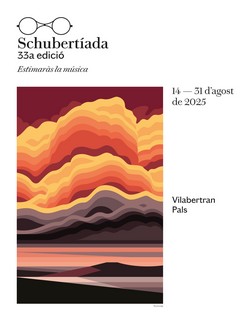
This is the music of a ruined castle in a timeless forest. The Lied is dominated by the image of the statue of the old knight who, between the ruins of the castle, thoughtful observes the waters of the Rhine from his cell. The tone of the lied is marvelously ambiguous: it begins as if it were e minor, but in the end the tonality seems rather a minor. This semi-modal harmony evokes antiquity and the static rhythm adds an oppressive quality. Its immobility is translated in the slow step of the music, of imperturbable and unappealable character. The rigor of the "old" style of counterpoint reinforces this feeling. The unique impassive gesture of the music fits the essential thought of Eichendorff, the indifferent slow course of time and the river.
The lied begins with a simple theme, exposed in counterpoint by all the voices. The long notes of the piano and the counterpoint style make us think more of an organ sound, and it is certainly a challenge for the pianists to find the appropriate touch to allow certain sounds to be maintained to enjoy the subtleties of Schumann's particular writing. The unchanging piano dynamic of the singer contributes to this idea of fixed sound. The phrases at this tempo seem very long, but the abundant punctuation marks in the text indicate where the singer can breathe. A progression directs the first verse towards a cadence suspended over the dominant, interrupted by the bass motif, which completely blurs the harmonic sense when presenting the tonic against the g# of the singer. This is one of the most spectacular examples of Schumann's art of offsetting harmonic and melodic discourse creating fantastic dissonances and sonorities. This melodic and harmonic dislocation is chilling, like a musical reflection of restlessness.
When the nuptial party is described, the dynamics may vary, the syncopation suggestively suggests life and movement. The singer can react with a gradual crescendo in the progression, but very measured, in the direction of "munter", where the musicians play festively. With this slight crescendo, the singer prepares the unpredictable and surprising change of direction on the last verse "und die schöne Braut, die wainet" (and the beautiful wife, she cries), emphasized by a dramatic ritard. This unexpected blow freezes the joyful summer day. The song does not tell us if the tears of the bride are of joy or sorrow. The disturbing Lied ends up over the dominant one, like an unsolved question, like a dilemma of the young wife.
This song has a strong relationship with other songs by Schumann, such as: Im Rhein de Dichterliebe and Zwielicht, by Liederkreis too.
Part of the inert meditative quality of this music was absorbed by Hugo Wolf in his version of Auf ein altes Bild (with Mörike's text) where another image is described in semi-modal tonality, with static rhythm and the final verse produces an unexpected turn.
Eingeschlafen auf der Lauer
Oben ist der alte Ritter;
Drüber gehen Regenschauer,
Und der Wald rauscht durch das Gitter.
Eingewachsen Bart und Haare
Und versteinert Brust und Krause,
Sitzt er viele hundert Jahre
Oben in der stillen Klause.
Draußen ist es still' und friedlich,
Alle sind ins Tal gezogen,
Waldesvögel einsam singen
In den leeren Fensterbogen.
Eine Hochzeit fährt da unten
Auf dem Rhein im Sonnenscheine,
Musikanten spielen munter,
Und die schöne Braut, die weinet.
Asleep on his watch
up there is the old knight;
above move rainshowers,
and the wood rustles through the grill.
Beard and hair grown into one,
chest and ruff have turned to stone;
he sits for many hundreds of years
above in his silent den.
Outside it is quiet and peaceful:
all have taken to the valley;
woodbirds sing alone
in the empty arching windows.
A wedding passes by below
on the Rhine, in the sunlight:
musicians play gaily
and the fair bride - she weeps.
(traducción de Emily Ezust)














Comments powered by CComment